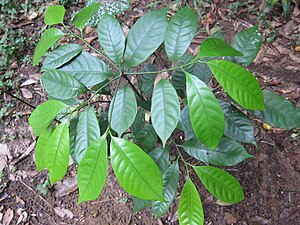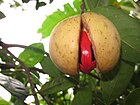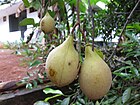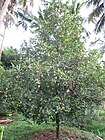Note: This is a project under development. The articles on this wiki are just being initiated and broadly incomplete. You can Help creating new pages.
Myristica fragrans - Mayaphala
Quercus infectoria is a species of oak, bearing galls that have been traditionally used for centuries in Asia medicinally. Quercus infectoria or locally known as Manjakani in Malaysia
Uses
Bleeding piles, Rectal bleeding, Irritable bowel syndrome, Liver disorders, Rectal prolapse, Uterine prolapse, Leucorrhea, Vaginitis, Toothache
Parts Used
Chemical Composition
Gallic Acid & Tannic Acid are found in Manjakani[1]
Common names
| Language | Common name |
|---|---|
| Kannada | ಜಾಕಾಯಿ Jakayi, ಜಾತೀಫಲ Jatiphala |
| Hindi | Maajoophal, Majuphal |
| Malayalam | Majakaanee, Mashikkay |
| Tamil | Machakaai, Masikki |
| Telugu | Machikaaya |
| Marathi | NA |
| Gujarathi | NA |
| Punjabi | NA |
| Kashmiri | NA |
| Sanskrit | Mayaphala, Majuphul |
| English | Oak Galls, Magic Nuts |
Properties
Reference: Dravya - Substance, Rasa - Taste, Guna - Qualities, Veerya - Potency, Vipaka - Post-digesion effect, Karma - Pharmacological activity, Prabhava - Therepeutics.
Dravya
Rasa
Kashaya (Astringent)
Guna
Laghu (Light), Ruksha (Dry)
Veerya
Sheeta (cold)
Vipaka
Katu (Pungent)
Karma
Kapha, Pitta
Prabhava
Habit
Identification
Leaf
| Kind | Shape | Feature |
|---|---|---|
| Simple | Alternate | Estipulate; petiole 9-15 mm long, slender, grooved above, glabrous; lamina 9-18 x 2.5-6 cm, elliptic |
Flower
| Type | Size | Color and composition | Stamen | More information |
|---|---|---|---|---|
| Unisexual | Yellow | 9-12 | Male flowers: 3-5 in axillary cymes, urceolate; pedicels drooping; bracts deciduous; bracteoles persistent |
Fruit
| Type | Size | Mass | Appearance | Seeds | More information |
|---|---|---|---|---|---|
| Fleshy capsule | 5 cm | Aril red, lacinate; seed brown | {{{6}}} |
Other features
List of Ayurvedic medicine in which the herb is used
Where to get the saplings
Mode of Propagation
How to plant/cultivate
Seed - best sown when fresh. Germination usually takes place in 5 - 6 weeks. Seed in the shell takes some 4 - 6 weeks to germinate.[4]
Commonly seen growing in areas
Photo Gallery
References
External Links
- Ayurvedic Herbs known to be helpful to treat Bleeding piles
- Ayurvedic Herbs known to be helpful to treat Rectal bleeding
- Ayurvedic Herbs known to be helpful to treat Irritable bowel syndrome
- Ayurvedic Herbs known to be helpful to treat Liver disorders
- Ayurvedic Herbs known to be helpful to treat Rectal prolapse
- Ayurvedic Herbs known to be helpful to treat Uterine prolapse
- Ayurvedic Herbs known to be helpful to treat Leucorrhea
- Ayurvedic Herbs known to be helpful to treat Vaginitis
- Ayurvedic Herbs known to be helpful to treat Toothache
- Herbs with Leaves used in medicine
- Herbs with common name in Kannada
- Herbs with common name in Hindi
- Herbs with common name in Malayalam
- Herbs with common name in Tamil
- Herbs with common name in Telugu
- Herbs with common name in Sanskrit
- Herbs with common name in English
- Habit - Shrub
- Index of Plants which can be propagated by Seeds
- Index of Plants which can be propagated by Cuttings
- Herbs that are commonly seen in the region of Evergreen forest
- Herbs that are commonly seen in the region of Western ghats
- Herbs
- Myristicaceae








